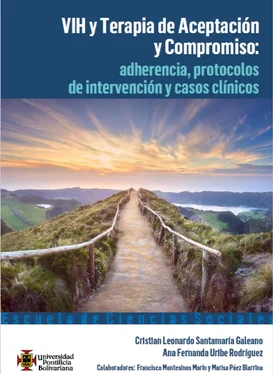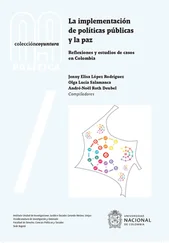Fondo Colombiano de Enfermedades de Alto Costo. (2014). Situación del VIH/SIDA en Colombia. Recuperado de https://cuentadealtocosto.org/site/images/Publicaciones/CAC.CO_20150814_LIBROVIH2014_V-0.0.VERSI%-C3%93N%20FINAL---.pdf
Fondo Nacional de Recursos (2019). Tratamiento antirretroviral de la infección VIH. Recuperado de http://www.fnr.gub.uy/info_vih
Fuster, M. & Molero, F. (2011). La percepción del estigma en las personas con VIH: sus efectos y formas de afrontamiento. (Tesis doctoral). Universidad Nacional de Educación a Distancia, Madrid.
Gatell, J., Clotet, B., Podzamczer, D., Miró, J. & Mallolas, J. (2013). Guía práctica del SIDA, clínica, diagnóstico y tratamiento. Editorial Antares: Barcelona.
GESIDA (2019). Documento de consenso de GeSIDA/Plan Nacional sobre el sida respecto al tratamiento antirretroviral en adultos con infección por el virus de la inmunodeficiencia humana (actualización enero 2019). Recuperado de http://gesida-seimc.org/wp-content/uploads/2018/12/gesida_DC_TAR_2019_Borrador_10_12_18.pdf
Goffman, E. (2009). Stigma: Notes on the management of spoiled identity . Simon and Schuster.
Golub, S. A., Gamarel, K. E. & Rendina, H. J. (2014). Loss and growth: Identity processes with distinct and complementary impacts on well-being among those living with chronic illness. Psychology, health & medicine , 19(5), 572-579.
Gonzalez, J. S., Batchelder, A. W., Psaros, C. & Safren, S. A. (2011). Depression and HIV/AIDS treatment nonadherence: a review and meta-analysis. Journal of acquired immune deficiency syndromes (1999) , 58(2).
Gonzalez, A., Solomon, S. E., Zvolensky, M. J. & Miller, C. T. (2009). The interaction of mindful-based attention and awareness and disengagement coping with HIV/AIDS-related stigma in regard to concurrent anxiety and depressive symptoms among adults with HIV/AIDS. Journal of health psychology, 14 (3), 403-413.
Hernández, D. & Pérez, J. (2010). Causas de cambio de tratamiento en un grupo de pacientes VIH/SIDA cubanos. Revista Cubana de Investigaciones Biomédicas, 29 (2), 223-228.
Hightower, M. & Kallas, E. (2003). Diagnosis, antiretroviral therapy, and emergence of resistance to antiretroviral agents in HIV-2 infection: a review. Brazilian Journal of Infectious Diseases, 7 (1), 7-15.
InfoSIDA (2017). ¿Qué es el tratamiento ARV? Recuperado de http://www.infosida.es/que-es-el-tratamiento-arv#
InfoSIDA (2018). Las fases de la infección por el VIH. Recuperado de https://infosida.nih.gov/education-materials/fact-sheets/19/46/las-fases-de-la-infeccionpor-el-vih
InfoSIDA (2019). Tratamiento del VIH. Cuándo empezar el tratamiento antirretroviral. Recuperado de https://infosida.nih.gov/understanding-hiv-aids/fact-sheets/21/52/cuando-empezar-el-tratamiento-antirretroviral
Instituto de Salud Carlos III (2019). Unidad de vigilancia del VIH y conductas de riesgo. Vigilancia epidemiológica de las infecciones de transmisión sexual, 2017. Madrid: Centro Nacional de Epidemiología, Instituto de Salud Carlos III/Plan Nacional sobre el Sida, Dirección General de Salud Pública, Calidad e Innovación. Recuperado de http://www.isciii.es/ISCIII/es/contenidos/fd-servicios-cientifico-tecnicos/fd-vigilancias-alertas/fd-enfermedades/fd-sida/pdf_sida/Vigilancia_ITS_1995_2017_def.pdf
Jin, H., Atkinson, J. H., Yu, X., Heaton, R. K., Shi, C., Marcotte, T. P., ... & Grant, I. (2006). Depression and suicidality in HIV/AIDS in China. Journal of affective disorders, 94(1-3), 269-275.
Klatzmann, D., Champagne, E., Chamaret, S., Gruest, J., Guetard, D., Hercend, T. et al. (1984). T-lymphocyte T4 molecule behaves as the receptor for human retrovirus LAV. Nature, 312 (5996), 767-768.
Lamotte, J. (2004). Infección-enfermedad por VIH/SIDA. Revista Médica de Santiago de Cuba, 8 (4), 49-63.
Lamotte, J. (2014). Infección por VIH/sida en el mundo actual. Revista Médica de Santiago de Cuba, 18 (7), 117-138.
Link, B. G., & Phelan, J. C. (2001). Conceptualizing stigma. Annual review of Sociology, 27(1), 363-385.
Logie, C., & Gadalla, T. M. (2009). Meta-analysis of health and demographic correlates of stigma towards people living with HIV. AIDS care, 21(6), 742-753.
Longo D.L. & Fauci A.S. (2018). The Human Retroviruses. En Jameson, J., Fauci, A.S., Kasper, D.L., Hauser, S.L., Longo, D.L., Loscalzo, J. Jameson J, Fauci A.S., Kasper D.L., Hauser S.L., Longo D.L., Loscalzo J Eds. J. Larry Jameson, et al.eds. Harrison’s Principles of Internal Medicine, 20e. New York, NY: Mc-Graw-Hill.
Major, B. & O´Brien, L.T. (2005). The Social Psychology of Stigma. Annual Review of Psychology, 56, 393-421.
Marrazzo, J.M. & Holmes, K.K. (2018). Marrazzo J.M., Holmes K.K. Marrazzo, Jeanne M., and King K. Holmes.Sexually Transmitted Infections: Overview and Clinical Approach. En Jameson, J., Fauci, A.S., Kasper, D.L., Hauser, S.L., Longo, D.L., Loscalzo, J. Jameson J, Fauci A.S., Kasper D.L., Hauser S.L., Longo D.L., Loscalzo J Eds. J. Larry Jameson, et al.eds. Harrison’s Principles of Internal Medicine, 20e. New York, NY: McGraw-Hill.
McArthur, J. C., Steiner, J., Sacktor, N., & Nath, A. (2010). Human immunodeficiency virus-associated neurocognitive disorders: mind the gap. Annals of neurology, 67(6), 699-714.
Ministerio de Salud Chile (2010). Guía clínica síndrome de inmunodeficiencia adquirida VIH/SIDA. Recuperado de http://www.who.int/hiv/pub/guidelines/chile_art.pdf
Ministerio de Salud y Protección Social & Fondo de Población de las Naciones Unidas (2014). Guía de práctica clínica basada en la evidencia científica para la atención de la infección por VIH/SIDA en adolescentes (con 13 años de edad o más) y adultos. Recuperado de http://www.consultorsalud.com/sites/consultorsalud/files/gpc_vih_adultos_completa_2015.pdf
Ministerio de Sanidad, Servicios Sociales e Igualdad (2013). Informe de evaluación plan multisectorial de VIH-SIDA 2008 – 2012. Madrid
Ministerio de Sanidad, Servicios Sociales e Igualdad (2014). Los perfiles de la discriminación en España. Madrid. Recuperado de http://www.mscbs.gob.es/va/ssi/igualdadOportunidades/noDiscriminacion/documentos/Perfiles_discriminacion.pdf
Moitra, E., Herbert, J. & Forman, E. (2011). Acceptance-Based Behavior Therapy to Promote HIV Medication Adherence. AIDS Care, 23 (12), 1-8.
Monforte, A., Testa, L., Adorni, F., Chiesa, E., Bini, T., Moscatelli, G. et al. (1998). Clinical outcome and predictive factors of failure of highly active antiretroviral therapy in antiretroviral-experienced patients in advanced stages of HIV-1 infection. AIDS, 12 (13), 1631-1637.
Muñoz, H. & Merino, L. (2015). Infección de transmisión sexual en pacientes de 15 a 49 años de edad que acuden al centro de salud de la parroquia Timbara, durante el año 2014. Tesis para optar al título de Licenciado en Enfermería, Universidad Nacional de Loja, Ecuador.
Nachega, J. B., Morroni, C., Zuniga, J. M., Sherer, R., Beyrer, C., Solomon, S., ... & Rockstroh, J. (2012). HIV-related stigma, isolation, discrimination, and serostatus disclosure: a global survey of 2035 HIV-infected adults. Journal of the International Association of Physicians in AIDS Care, 11(3), 172-178.
Nanni, M. G., Caruso, R., Mitchell, A. J., Meggiolaro, E., & Grassi, L. (2015). Depression in HIV infected patients: a review. Current psychiatry reports, 17(1), 530.
Ogden, J. y Nyblade, L. (2005). Common at its Core: HIV-related stigma across context. Washington: International Center for Research of Women. Recuperado de www.icrw.org
Olley, B. O., Seedat, S., Nei, D. G., & Stein, D. J. (2004). Predictors of major depression in recently diagnosed patients with HIV/AIDS in South Africa. AIDS patient care and STDs, 18(8), 481-487.
Omiya, T., Yamazaki, Y., Shimada, M., Ikeda, K., Ishiuchi-Ishitani, S., Tsuno, Y. S., & Ohira, K. (2014). Mental health of patients with human immunodeficiency virus in Japan: a comparative analysis of employed and unemployed patients. AIDS care, 26(11), 1370-1378.
Читать дальше












